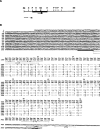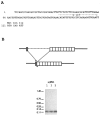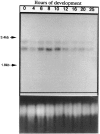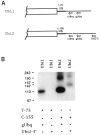Structure and expression of a polyubiquitin gene from the crustacean Artemia
- PMID: 7841785
- PMCID: PMC6134374
Structure and expression of a polyubiquitin gene from the crustacean Artemia
Abstract
We have characterized two polyubiquitin genes from the crustacean Artemia franciscana. One of them, Ubi1, has nine ubiquitin units and an intron of a minimum size of 3.5 kb that ends 7 bp before the initiator ATG. The 5' end of the transcript from this gene has been identified by anchored PCR. The existence of the other gene (Ubi2) was inferred from several cDNA clones that differ from Ubi1 in the C-terminal extension and in the 3' untranslated region as well as in the nucleotide sequence of the coding region. We find two transcripts of ubiquitin genes, of 2.7 and 3.3 kb. Hybridization of RNA blots with an oligonucleotide specific for Ubi2 gene demonstrates that this gene codes for the 3.3 kb transcript. Ubiquitin messenger RNAs are present in the dormant embryos and their steady-state levels are maximum at 8 h after resumption of development, declining thereafter. The Ubi2 gene transcripts are less abundant but its proportion in relation to the other transcript does not vary with development.
Figures






Similar articles
-
Nucleotide sequence and expression of the rat polyubiquitin mRNA.Biochim Biophys Acta. 1994 Jun 21;1218(2):232-4. doi: 10.1016/0167-4781(94)90020-5. Biochim Biophys Acta. 1994. PMID: 8018730
-
Repetitious structure and transcription control of a polyubiquitin gene in Volvox carteri.Curr Genet. 1994 Feb;25(2):169-77. doi: 10.1007/BF00309544. Curr Genet. 1994. PMID: 8087887
-
Molecular characterization of ubiquitin genes from Aspergillus nidulans: mRNA expression on different stress and growth conditions.Biochim Biophys Acta. 2000 Feb 29;1490(3):237-44. doi: 10.1016/s0167-4781(99)00242-0. Biochim Biophys Acta. 2000. PMID: 10684969
-
Structure and evolution of genes encoding polyubiquitin in marine sponges.Prog Mol Subcell Biol. 1998;21:157-81. doi: 10.1007/978-3-642-72236-3_8. Prog Mol Subcell Biol. 1998. PMID: 9928541 Review. No abstract available.
-
Artemia mitochondrial genome: molecular biology and evolutive considerations.Comp Biochem Physiol B Biochem Mol Biol. 1997 Jul;117(3):357-66. doi: 10.1016/s0305-0491(96)00338-0. Comp Biochem Physiol B Biochem Mol Biol. 1997. PMID: 9253173 Review.
Cited by
-
Actin gene structure in two Artemia species, A. franciscana and A. parthenogenetica.J Mol Evol. 1996 Sep;43(3):224-35. doi: 10.1007/BF02338830. J Mol Evol. 1996. PMID: 8703088
References
-
- Browne R. A., Sorgeloos P., and Trotman C. N. A. (1991), Artemia Biology, CRC Press, Boca Raton, FL.
-
- Busch H. and Goldknopf L. L. (1981), Mol Cell Biochem 40, 173–187. - PubMed
Publication types
MeSH terms
Substances
Associated data
- Actions
- Actions
LinkOut - more resources
Full Text Sources
